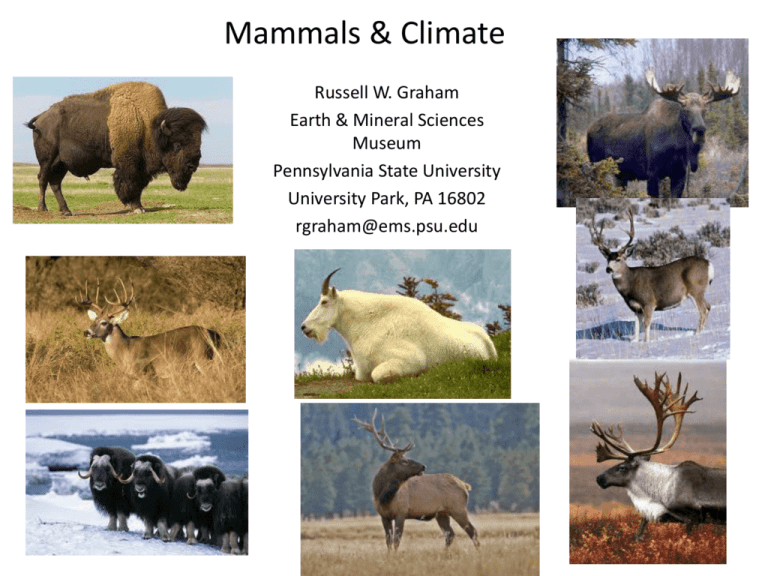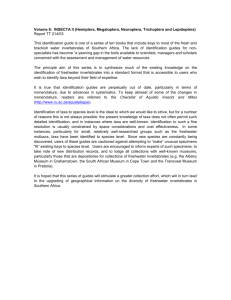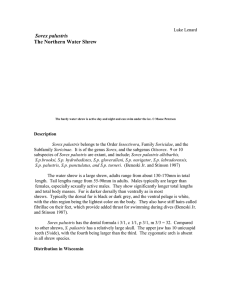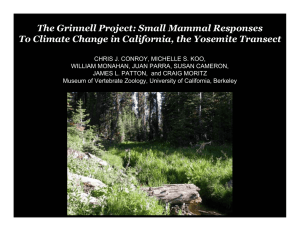Mammals & Climate
advertisement

Mammals & Climate Russell W. Graham Earth & Mineral Sciences Museum Pennsylvania State University University Park, PA 16802 rgraham@ems.psu.edu Vertebrate fossil collection Megafauna collection Microfossil collection Excavating & bagging sediment with bones Screen washing Sediment for bones A volunteer excavates around a mammoth vertebra at the Pratt Mammoth site, KS boneblogger.com/mapping-the-pratt-mammoth-excavation-using-gps-and-basic-surveying-technology Picking screenwash Concentrate for bones Why Mammals Abundant sites and specimens with electronic databases Excellent Geographic Coverage Can directly date individual specimens Small mammals can not migrate (local environment) Can be identified to generic and frequently species level Ecology of modern forms well studied so good proxies http://www.mnh.si.edu/mna/about.cfm Many taxa are limited to specific habitats Databases http://www.neotomadb.org/ http://www.ucmp.berkeley.edu/miomap/ Accuracy and Precision of AMS Radiocarbon Dating Bone From T. S. Stafford, Jr. Individual specimens as small as rodent and insectivore skulls & jaws can be dated And in some cases even isolated teeth and Fragmentary bones can be dated accurately and precisely From T. S. Stafford, Jr. Identification of Shrews Sorex palustris (water shrew) Blarina brevicauda (short tailed shrew) Cryptotis parva (least shrew) Barren ground musk oxen (Ovibos moschatus) have specific physiological and anatomical adaptations for cold climates Modern (shaded in inset) & Late Pleistocene (dots) distribution of the collared lemming (Dicrostonyx sp.) in North America Morphological and physiological Adaptations for cold climates Winter pelage Summer pelage Data from Neotoma Database Modern environment Brown lemmings (Lemmus trimucronatus) have behavioral adaptations for cold climate Subnivian environment protects the brown lemming from the cold. Squirrels – Habitats – Climate Grassland “Dry” Glaucomys -------------------------------------------------------- Forest “Moist” Prairie dog –-shortgrass Cynomys Marmot – grassy area in coniferous forest or alpine tundra – Marmota flaviventris Tamiasciurus Sciurus niger Chipmunk –woodland – Tamias Thirteen line ground squirrel – short to tall grass Spermophilus tridecemlineatus Sciurus carolinensis Woodchuck – grassy areas in forestMarmota monax Franklin’s ground squirrel – tall grass Spermophilus franklinii Tree Squirrels Closed Forest Squirrels & Vegetation No-analog Vegetation: Several Thousand Year Intervals & Extends into Holocene Non-analog Mammals: 500 year intervals, extend From Overpeck et al. 1992 throughout late Pleistocene & beyond, absent in Holocene Was there a continental-wide Clovis Drought? NO Taxa Sites WEST ------------------------------------------------------------ EAST LR-AZ AU-TX X X X X X LF-SD KW-MO Grassland/Dry/Warm Bison sp. Camelops hesternus Mammuthus columbi Perognathus sp. Onychomys leucopus Spermophilus sp. Geomys sp. Spermophilus franklini Spermophilus tridecemlineatus X X X X X X X X X Woodland/Forest/ Cool/Moist Tapirus merriami Ursus americanus Synaptomys cooperi Scalopus aquaticus Blarina sp. Sorex palustris Sorex hoyi Clethrionomys gapperi Zapus princeps Mylohyus sp. Mammut americanum Marmota monax Sciurus sp. X X X X X X X X X X X X X X X X Permanent Water Ondatra zibethica Osteichthyes Mustela vison X X X X X X X LR- Lehner Ranch, AZ; AU- Aubrey, TX; LF- Lange Ferguson, SD; KW-Kimmswick, MO • Selected Environmentally Sensitive Taxa from Clovis Sites (Data derived from Neotoma Database) Selected Environmentally Sensitive Taxa from Clovis Sites (Data derived from Neotoma Database)











